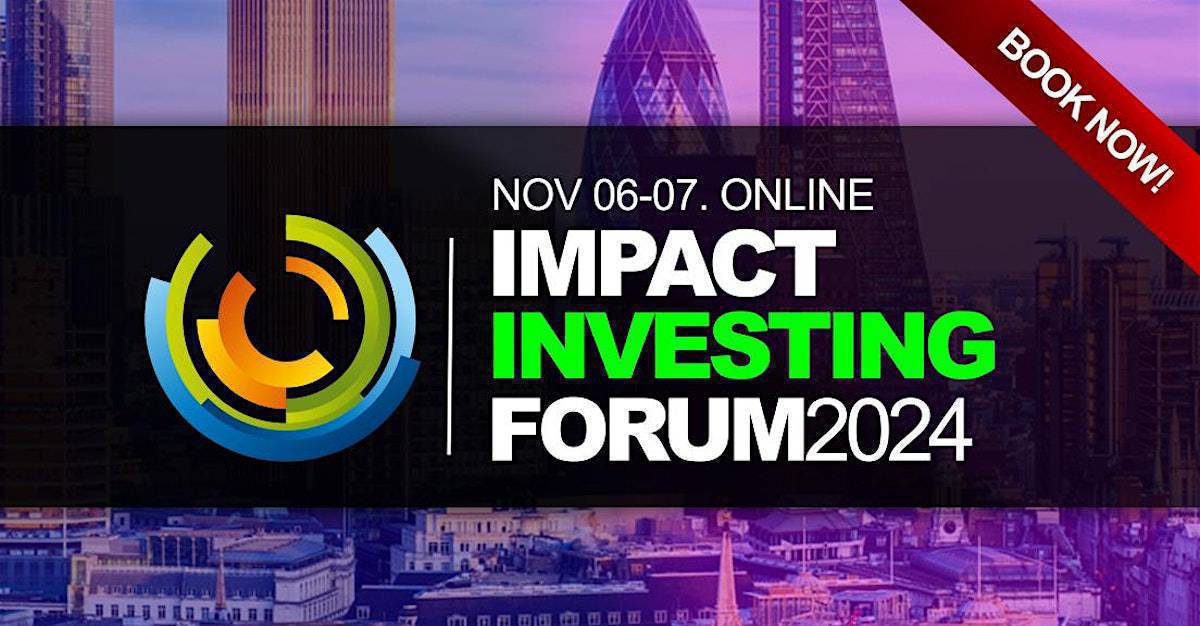Impact Investing at 15—A Look at Three Field Perspectives – Non Profit News Nonprofit QuarterlyFuture Returns: Impact Investing in Education Barron’sThe Dubious Financial Impact of Impact Investing – Articles advisorperspectives.comThe Challenge of Measuring Impact Performance – Knowledge@Wharton Knowledge@WhartonOpportunity Zone Impact Investing Survey, With Reid Thomas OpportunityDb
Impact Investing Forum 2024
https://impactinvestingconferences.com/
Online Event. Nov 06-07, 2024.
Book Now!
“Impact investing will not save us. It is not enough. Philanthropy will not save us. Social enterprise will not save us. We have to connect the dots and use all the social and financial capital tools we got.”
Deb Nelson, Executive Director, Just Economy Institute
As a term, impact investing turns 15 this year. What the term means, however, remains subject to interpretation. On the one hand, the concept is simply an expression of common sense. If a foundation, company, nonprofit, or individual allocates funds to an investment vehicle—be it a stock, bond, or private placement—it will have an impact of some kind, whether for good or ill.
On the other hand, the idea is to consciously leverage financial capital to advance social justice and build power in community. That’s a much taller order and 15 years in, despite the trillions nominally invested for impact—the jury is still out on effectiveness. Clearly, some investments advance transformative goals, but many do not.
Elaine Rasmussen, who participated over the past two years in Boston Impact Initiative’s national Fund Building Cohort, named some of these tensions in an interview with NPQ last year. “One of the ways I talk about this,” she said, “is there are the master’s tools, which is the current finance sector. I am of the belief that we can use the master’s tools to do what we’re trying to do within limits.”
Another complication is that impact investors have divergent goals. To explore how different actors are thinking about impact investing, I spoke with three people in the field: Otis Rolley, senior vice president of the US Equity and Economic Opportunity Initiative at the Rockefeller Foundation, the foundation that organized the 2007 convening where impact investing was coined; Miguel Santana, CEO of the Weingart Foundation in Southern California; and Deb Nelson from the Just Economy Institute.
Impact Investing at Rockefeller: Moving Money to BIPOC-Led Funds
Rolley, as noted above, heads the Rockefeller Foundation’s equity and economic opportunity work. One interesting thing to consider is that 15 years in, Rockefeller is still only at very early stages of developing a strategy to leverage the corpus of its endowment, which Rolley estimated at $6.4 billion; the foundation announced its intention to begin to do so in April 2021. Rolley adds that the foundation’s chief investment officer, its president, and its investment committee from the board of trustees “are looking into how to do more mission-related investments. We have divested from the fossil fuels. We are trying to be smart in terms of where and how…. We did some analysis that has to be done on where and how we invest and turn that ship.”
What Rockefeller has done, however, is make grants and program-related investments (low-interest loans) to expand access to capital in BIPOC communities. For example, the foundation disbursed a $500,000 grant to the REAL People’s Fund in Oakland, California—a fund that was featured last year in Transform Finance’s report on leading power-building “grassroots community engaged” impact investing funds nationally and which makes loans of $50,000 to $250,000 to BIPOC-owned firms. The acronym “REAL” stands for “Revolutionizing Our Economy for All Local People.” About the investment, Rolley said, “We found it very attractive and invested in it. We know if we are going to do something different, we have to do something different.”
Nor is REAL a one-off. Rockefeller also has backed CLLCTIVLY in Baltimore, which Rolley describes as a “BIPOC-led firm that is really looking at small and microloans both to BIPOC businesses as well as BIPOC-led nonprofits.” It has supported Founders First Capital Partners, which aims to lend to 400 BIPOC-owned firms and employs revenue-based financing; firms only pay if they have the available cash to do. This is also sometimes called “non-extractive financing.”
As Rolley explains, the way this works is that the firm pays a “fixed percentage of the revenue up to a predetermined cap so it doesn’t hurt their bottom line when they are paying it back.” In other words, loan payments remain limited if cash is short; if business performance exceeds expectations, the loan fund payments are higher than standard, up to the cap or maximum amount. This structure helps ensure that the interests of the loan fund and its business borrowers are aligned. Rolley adds that early data have shown “great numbers” that suggest the approach is working.
The foundation has also invested in employee ownership, serving as a lead backer of Apis & Heritage Capital Partners, which Rockefeller describes as a $30 million fund to “turn businesses with workforces of color into employee-owned firms.” The foundation, explains Rolley, sees “employee ownership is a crucial part of racial wealth gap in the long haul. That’s what attracted to us to it. It’s meeting a challenge of today. You can’t have a serious view of making real changes of BIPOC wealth creation without having serious conversation about innovative mechanisms to build up business ownership.”
These investments, Rolley adds, are part of a two-tier strategy that also involves supporting policy coalitions and research to promote public policy change—both federally and at the state and local level, particularly in the tax code—so that the wealthy pay more taxes and working people less.
What is the end goal? While some Rockefeller grantees may disagree, the foundation believes that “an inclusive capitalism” remains “a viable option for the US.” Rolley claims inclusive capitalism works elsewhere, based on an arguably rosy view of European social democracy. Impact investing, in this vision, is a tool designed to nudge the existing economic system towards greater equity and inclusion.
Using the Foundation Corpus to Shape Markets in Los Angeles
While Rockefeller is just starting to think about how to use its corpus for impact investing, the Weingart Foundation in Los Angeles is much further along. As Miguel Santana, once the city of Los Angeles’ chief administrative officer and the foundation’s CEO since 2020, details, “For the nearly billion-dollar corpus that we have as a corpus at the foundation, we are looking very seriously in our investments to not only ask the question are they counter to our mission, but how these investments are advancing our mission. The work of the foundation is broader than our grants.” Although Santana arrived at Weingart recently, the foundation’s investment policy shift predates him by four years. Today, half of its corpus is invested in mission-aligned ways—and the foundation is moving toward having 100 percent of its investments aligned with mission.
The first step in shifting investment, Santana notes, is to conduct what he calls a “do no harm” look—in other words, divest from industries that are harming the community. This is followed by conducting due diligence to determine whether the groups that are managing foundation assets “represent our values.” Given Weingart’s racial justice frame, this means asking if the investment professionals are diverse and if that diversity is “represented at different layers of an institution from its board to its executive team to people who are managing the assets? Those questions inform our decisions of who we actually partner with.”
One example Santana highlighted involved a $5 million investment in a for-profit builder of modular homes, which Santana contends is a much more cost-effective means of increasing the region’s low-cost housing supply and reducing its affordable housing shortage than traditional grant-funded housing. Santana is enthusiastic about the foundation’s approach. Whether the foundation’s bet is right remains to be seen. What is clear, however, is that this example speaks to one of the central challenges of impact investing—namely, to be an impact investor requires having capital to invest. In other words, if philanthropic decisions regarding impact investment are made, as they often are, without substantial community review, impact investment can become—even with the best of intentions—a tool that reinforces philanthropic power.
Impact Investment for Liberation? The Just Economy Institute
The Just Economy Institute began as a project of RSF Social Finance and became a standalone nonprofit in 2021. It is led by Deb Nelson, the daughter of a conservative entrepreneurial father and a social activist mother. In her career, Nelson has tried to combine both aspects, she explains. Nelson’s work seeks to understand and activate money “in wise ways to get to an economy that is just and works for all people and the planet.”
Nelson explains that the idea of the Just Economy Institute, which had its first cohort in 2017, was to look broadly at different promising models and strategies and connect different people and organizations “using an integrated holistic approach.”
Central to the group’s objective is to “shift the flow of power. There is such an incredible concentration of wealth and power in this country and in this world. Unless we also shift the flow of power, we’re not going to get to systemic change.” Each fellowship cohort brings together movement leaders, community organizations, financial advisors, wealth holders, and nonprofit leaders together as a community of practice to build knowledge about effective interventions.
What does systemic change require? Nelson is clear on the problems. “Our current form of capitalism is extractive capitalism. That is not working for people or the planet. That is crystal clear,” she says. The goal, she adds, “is an economy that supports the well-being of the people. That is a regenerative, restorative economy.”
The methodology remains a work in progress, but Nelson is certain that developing a restorative economy requires a shift in who makes impact investing decisions—and that better due diligence by itself is not sufficient. As Nelson puts it: “The wealth holders are not saying, ‘This is how and when and how much capital will flow.’ It is the movement leaders who are making those decisions. That is part of our theory of change.” Over time, Nelson notes, there has been a shift in both the fellowship she directs and the field, which she describes as “anchoring on racial and economic justice while not losing our focus on environmental justice.”
Can impact investing truly be liberatory? Nelson is hopeful that “we are beginning the long and hard and joyful work of creating new systems that get us to a just and sustainable economy. We of course are not there yet. But we are in a place where people are awake and seeing that different systems are possible. They are seeing things work in their local communities.” Nelson cites the growing impact of the Movement for Black Lives, as well as the rise of radical philanthropic groups and foundations such as Kataly, Solidaire, and Resource Generation. “What I am seeing as the movements are coming together, as the leaders are coming together … [is that] this is our time.” She also observes that the stakes are very high. “This is our time because we have to get it right. If we don’t work on these issues and affect systems change in this decade, the repercussions are catastrophic.”


